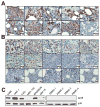Constitutive activation of p38 MAPK in tumor cells contributes to osteolytic bone lesions in multiple myeloma
- PMID: 22425892
- PMCID: PMC3381862
- DOI: 10.1038/leu.2012.71
Constitutive activation of p38 MAPK in tumor cells contributes to osteolytic bone lesions in multiple myeloma
Erratum in
- Leukemia. 2015 Feb;29(2):515
Abstract
Bone destruction is a hallmark of multiple myeloma and affects more than 80% of patients. However, current therapy is unable to completely cure and/or prevent bone lesions. Although it is accepted that myeloma cells mediate bone destruction by inhibition of osteoblasts and activation of osteoclasts, the underlying mechanism is still poorly understood. This study demonstrates that constitutive activation of p38 mitogen-activated protein kinase in myeloma cells is responsible for myeloma-induced osteolysis. Our results show that p38 is constitutively activated in most myeloma cell lines and primary myeloma cells from patients. Myeloma cells with high/detectable p38 activity, but not those with low/undetectable p38 activity, injected into severe combined immunodeficient (SCID) or SCID-hu mice caused bone destruction. Inhibition or knockdown of p38 in human myeloma reduced or prevented myeloma-induced osteolytic bone lesions without affecting tumor growth, survival, or homing to bone. Mechanistic studies showed that myeloma cell p38 activity inhibited osteoblastogenesis and bone formation and activated osteoclastogenesis and bone resorption in myeloma-bearing SCID mice. This study elucidates a novel molecular mechanism-activation of p38 signaling in myeloma cells-by which myeloma cells induce osteolytic bone lesions, and indicates that targeting myeloma cell p38 may be a viable approach to treating or preventing myeloma bone disease.
Conflict of interest statement
No potential conflicts of interest were disclosed.
Figures







Similar articles
-
p38 MAPK in myeloma cells regulates osteoclast and osteoblast activity and induces bone destruction.Cancer Res. 2012 Dec 15;72(24):6393-402. doi: 10.1158/0008-5472.CAN-12-2664. Epub 2012 Oct 11. Cancer Res. 2012. PMID: 23066034 Free PMC article.
-
Inhibition of p38alpha mitogen-activated protein kinase prevents the development of osteolytic bone disease, reduces tumor burden, and increases survival in murine models of multiple myeloma.Cancer Res. 2007 May 15;67(10):4572-7. doi: 10.1158/0008-5472.CAN-06-4361. Epub 2007 May 10. Cancer Res. 2007. PMID: 17495322
-
Role of Bruton's tyrosine kinase in myeloma cell migration and induction of bone disease.Am J Hematol. 2013 Jun;88(6):463-71. doi: 10.1002/ajh.23433. Epub 2013 Mar 28. Am J Hematol. 2013. PMID: 23456977 Free PMC article.
-
Pathogenesis of myeloma bone disease.Blood Cells Mol Dis. 2004 Mar-Apr;32(2):290-2. doi: 10.1016/j.bcmd.2004.01.001. Blood Cells Mol Dis. 2004. PMID: 15003820 Review.
-
Pathophysiology of multiple myeloma bone disease.Hematol Oncol Clin North Am. 2007 Dec;21(6):1035-49, viii. doi: 10.1016/j.hoc.2007.08.009. Hematol Oncol Clin North Am. 2007. PMID: 17996587 Review.
Cited by
-
Mouse models of multiple myeloma: technologic platforms and perspectives.Oncotarget. 2018 Apr 13;9(28):20119-20133. doi: 10.18632/oncotarget.24614. eCollection 2018 Apr 13. Oncotarget. 2018. PMID: 29732008 Free PMC article. Review.
-
HIF-1α suppresses myeloma progression by targeting Mcl-1.Int J Clin Exp Pathol. 2020 Jul 1;13(7):1483-1491. eCollection 2020. Int J Clin Exp Pathol. 2020. PMID: 32782666 Free PMC article.
-
Myeloma cells shift osteoblastogenesis to adipogenesis by inhibiting the ubiquitin ligase MURF1 in mesenchymal stem cells.Sci Signal. 2020 May 26;13(633):eaay8203. doi: 10.1126/scisignal.aay8203. Sci Signal. 2020. PMID: 32457115 Free PMC article.
-
Resistin induces multidrug resistance in myeloma by inhibiting cell death and upregulating ABC transporter expression.Haematologica. 2017 Jul;102(7):1273-1280. doi: 10.3324/haematol.2016.154062. Epub 2017 Mar 30. Haematologica. 2017. PMID: 28360146 Free PMC article.
-
Plumbagin induces G2/M arrest, apoptosis, and autophagy via p38 MAPK- and PI3K/Akt/mTOR-mediated pathways in human tongue squamous cell carcinoma cells.Drug Des Devel Ther. 2015 Mar 16;9:1601-26. doi: 10.2147/DDDT.S76057. eCollection 2015. Drug Des Devel Ther. 2015. PMID: 25834400 Free PMC article.
References
-
- Roodman GD. Myeloma bone disease: pathogenesis and treatment. Oncology (Williston Park) 2005 Jul;19(8):983–984. 986. - PubMed
-
- Tian E, Zhan F, Walker R, Rasmussen E, Ma Y, Barlogie B, et al. The role of the Wnt-signaling antagonist DKK1 in the development of osteolytic lesions in multiple myeloma. N Engl J Med. 2003 Dec 25;349(26):2483–2494. - PubMed
-
- Giuliani N, Rizzoli V, Roodman GD. Multiple myeloma bone disease: Pathophysiology of osteoblast inhibition. Blood. 2006 Dec 15;108(13):3992–3996. - PubMed
-
- Wang S, Hong S, Yang J, Qian J, Zhang X, Shpall E, et al. Optimizing immunotherapy in multiple myeloma: Restoring the function of patients’ monocyte-derived dendritic cells by inhibiting p38 or activating MEK/ERK MAPK and neutralizing interleukin-6 in progenitor cells. Blood. 2006 Dec 15;108(13):4071–4077. - PMC - PubMed
Publication types
MeSH terms
Substances
Grants and funding
LinkOut - more resources
Full Text Sources
Medical
Molecular Biology Databases

